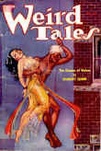
.:Overview:.

The vampire mythos saw little development in the years from the First World War to the mid-fifties. Pulp fiction magazines, succeeding the penny-dreadfuls of the Victorian era, were the primary lair of the literary vampire. The pulps featured many stories by now well known authors such as H.P. Lovecraft and Robert Howard but very little in the way of innovation in their tales about vampires. Collectively they carried on the trend of casting vampires as romantic figures. Dracula era vampires had been primarily motivated by blood, showing little concern with the gender of their victims. Vampires featured in the pulps were mainly males who seduce nubile female victims.
In the 1950s there began to be some innovation in vampire fiction. Two significant works of the period were Fritz Lieber's The Girl With the Hungry Eyes 1949, in which the vampire feeds upon feelings of love and Mindworm 1955 by C M Kornbluth, in which the vampire is a psychic entity traveling from one body to another drinking the emotions of its victims.
I Am Legend 1954 by author Richard Matheson was influential in breaking literary vampires from the mold the pulps had cast them in for several decades. Melding vampire and science fiction, Matheson created a world overrun with cannibalistic blood-drinking creatures spawned by a pandemic from a bacterium that causes vampirism. A single man is the sole survivor. He must fight to survive attacks from nocturnal hordes, discover the secrets of their biology, and develop effective countermeasures. I Am Legend widened and changed the genre forever. It was made into into three movies: The Last Man on Earth starring Vincent Price in 1964, The Omega Man starring Charleton Heston in 1971, and I am Legend (film) starring Will Smith in 2007.
With rare exceptions, vampire literature was in a lull from the mid 50s to the 70s. Even comic books had banned vampire characters from their pages. In 1955 the comix code was revised to forbid "the picturing of, among other things, scenes of depravity, sadism, or excessive gruesomeness". One paragraph dealt forcefully with the major characters associated with the horror story: Scenes dealing with, or instruments associated with the walking dead, torture, vampires and vampirism, ghouls, cannibalism and werewolves are prohibited. It wasn't until 1972 that the code was relaxed allowing vampires to reappear.
The 1970s witnessed a renaissance of vampire literature. Leading the way was Gothic romance writer Marilyn Ross's Barnabas Collins series (1966–71) loosely based on the contemporary American TV series Dark Shadows. Ross helped establish the trend towards depicting the vampire as a poetic, tragic hero rather than an embodiment of evil, and set the stage for the entry of Anne Rice. Nineteen Seventy-five saw publication of Stephen King's Salem's Lot, 1976 the first of Anne Rice's immensely popular Vampire Chronicles series, Interview with the Vampire, and 1978 the first of Chelsea Quinn Yarbro's massive St. Germain series, Hotel Transylvania. Ross, Rice and Yarbo presided over the rise of the multi-volume vampire sagas which are now a stock feature of mass-market fiction. (see List) The fiction of Anne Rice also saw the beginning of the convergence of traditional Gothic ideas with the modern Gothic subculture and a more explicit exploration of the transgressive sexualities which had always been implicit in vampire fiction.
Anne Rice's Vampire Chronicles ended after many years, but many others have started up in the meantime. Paranormal romance, inspired by Rice, but mostly dropping the transgressive sexuality of her characters in favour of more conventional sexual roles, is an ongoing contemporary publishing phenomenon. The most prominent exponent of this sub-genre is Christine Feehan. Other romances with handsome vampires as the male leads include Lynsay Sands' Argegneau Family series (2003–). However Laurell K. Hamilton's Anita Blake: Vampire Hunter series has again shifted the genre boundaries from romance back toward the territory of erotica.








 White Wolf, makers of Vampire the Masquerade, the most popular vampire role playing game of all time, released Blood and Roses, the critically acclaimed first in a series of 13 novels (1991-2004) based on the thirteen vampire clans of the Masquerade. Reviewers have said the series is uneven, some books being well received and others considered to be of poor quality.
White Wolf, makers of Vampire the Masquerade, the most popular vampire role playing game of all time, released Blood and Roses, the critically acclaimed first in a series of 13 novels (1991-2004) based on the thirteen vampire clans of the Masquerade. Reviewers have said the series is uneven, some books being well received and others considered to be of poor quality. 




